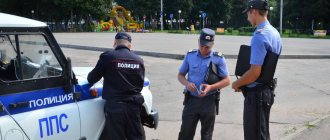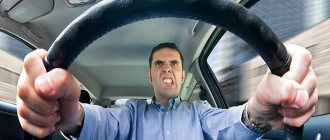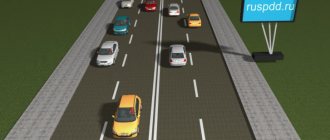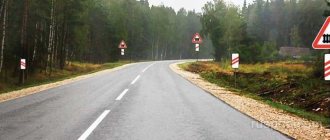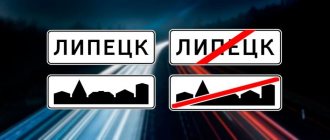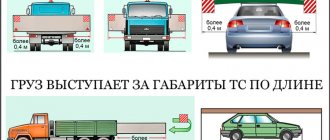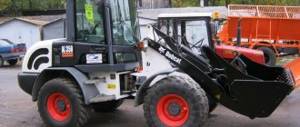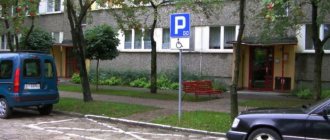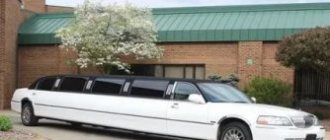Do minibuses have MTS privileges?
Is a minibus a route vehicle or not?
In the 21st century in Russia, such a type of public transport as a minibus taxi has become widespread. The Traffic Rules for route vehicles have a number of privileges. Hence the dispute arose whether a “minibus” is a route vehicle in accordance with the definition of traffic rules.
“Route vehicle” is a public vehicle (bus, trolleybus, tram) intended for transporting people on roads and moving along a set route with designated stopping places.
“Marshrutka” is a route vehicle:
- a public vehicle intended for transporting people on roads;
- moving along a set route.
“Minibus” is not a route vehicle:
- This is not a bus;
- It has no designated stopping places.
So can a minibus enjoy the privileges of the Traffic Rules for minibuses?
What is needed to open
In accordance with the provisions of Article 8 of Law No. 294-FZ, the organization is obliged to notify the municipal body that regulates transport about the start of work in the field of passenger transportation.
An organization or individual entrepreneur is required to obtain a license to transport passengers in vehicles with more seats for passengers 8.
To obtain a work permit you must:
- have the premises and equipment necessary for the maintenance and repair of minibus taxis (or a valid contract with a third-party organization providing the described services);
- enter into contracts with drivers who have a driver’s license of the appropriate category and driving experience (at least 3 years );
- obtain a license to provide medical services for conducting pre-trip examinations of drivers or enter into an agreement with a third-party organization for the provision of services;
- purchase or rent cars, the design of which makes it possible to transport passengers along a given route;
- equip vehicles with tachographs;
- equip vehicles with GLONASS/GPS.
Stops
The movement of public transport is regulated by the charter of road transport and urban ground electric transport and the rules for the transportation of passengers and luggage by road transport and urban ground electric transport. The movement of minibuses in accordance with these documents refers to the regular transportation of passengers and luggage. Transportation is classified not by type of vehicle (bus, tram, trolleybus), but by vehicle category (M1, M2, M3).
“Minibuses” belong to the M2 category
“vehicle of category “M2” - a vehicle that is used to transport passengers, has, in addition to the driver’s seat, more than 8 seats and whose maximum weight does not exceed 5 tons;
3. Regular transportation of passengers and baggage is divided into:
transportation with passengers boarding and disembarking only at established stopping points along the regular transportation route; transportation with pick-up and drop-off of passengers in any place not prohibited by traffic rules along the route of regular transportation.
“Minibuses” can refer to any of these types of transportation.
5. Transportation with pick-up and disembarkation of passengers in any place not prohibited by traffic rules along the regular transport route is carried out in accordance with the schedules established for travel from the starting and final stopping points along the regular transport route. Vehicle stops for boarding and disembarking passengers are carried out at the initial and final stopping points along the route of regular transportation, as well as at the request of passengers.
This type of transportation also has two designated stopping points - initial and final, which corresponds to the definition in the Traffic Rules.
“Minibus” is a route vehicle and can enjoy the privileges of the Road Traffic Rules for route vehicles.
Subscribe to the channel, like, and don’t miss a lot of interesting things about traffic rules.
Source
Is a minibus a route vehicle or not?
In the 21st century in Russia, such a type of public transport as a minibus taxi has become widespread. The Traffic Rules for route vehicles have a number of privileges. Hence the dispute arose whether a “minibus” is a route vehicle in accordance with the definition of traffic rules.
“Route vehicle” is a public vehicle (bus, trolleybus, tram) intended for transporting people on roads and moving along a set route with designated stopping places.
"Marshrutka" is a route vehicle:
- a public vehicle intended for transporting people on roads;
- moving along a set route.
"Minibus" is not a route vehicle:
- This is not a bus;
- It has no designated stopping places.
So can a minibus enjoy the privileges of the Traffic Rules for minibuses?
A minibus is not a bus
From the explanatory dictionary of foreign words (bus is a foreign word)
5. Transportation with pick-up and disembarkation of passengers in any place not prohibited by traffic rules along the regular transport route is carried out in accordance with the schedules established for travel from the starting and final stopping points along the regular transport route. Vehicle stops for boarding and disembarking passengers are carried out at the initial and final stopping points along the route of regular transportation, as well as at the request of passengers.
This type of transportation also has two designated stopping points - initial and final, which corresponds to the definition in the Traffic Rules.
“Minibus” is a route vehicle and can enjoy the privileges of the Traffic Rules for route vehicles.
For transport infrastructure objects of urban ground electric transport:
| The meaning of the OTI category | Number of ANVs committed and/or prevented on the territory of the Russian Federation, including in relation to categorized transport infrastructure facilities |
| First | Three or more perfected and/or prevented ANVs |
| Second | Two completed and/or prevented ANVs |
| Third | One completed and/or prevented ANV |
| Fourth |
Is a minibus a route vehicle?
Good afternoon, dear reader.
This article will discuss whether minibus taxis are route vehicles. In fact, there is nothing complicated about this issue, but it has raised questions among drivers for many years.
The answer to this question is necessary to know due to the fact that route vehicles in some cases have priority right of way, and also have the right to deviate from the requirements of some road signs.
For transport infrastructure objects of motor vehicles and road facilities:
| The meaning of the OTI category | Number of ANVs committed and/or prevented on the territory of the Russian Federation, including in relation to categorized transport infrastructure facilities |
| First | Six or more advanced and/or prevented ANVs |
| Second | Three to five ANVs committed and/or prevented |
| Third | No more than two committed and/or prevented ANVs |
| Fourth | Not a single committed and/or prevented ADV was recorded |
Is a minibus considered a route vehicle?
The situation is regulated by paragraph 1.2 of the traffic rules:
“Route vehicle” is a public vehicle (bus, trolleybus, tram) intended for transporting people on roads and moving along a set route with designated stopping places.
Conditions that confirm that in front of you is a route vehicle:
- The vehicle is a bus, trolleybus or tram.
- The vehicle is designed to transport people.
- The vehicle moves along the appropriate route.
All of the above conditions apply to minibuses. They are buses of category D or subcategory D1, they are designed to transport people and move along established routes.
So the minibus is a route vehicle and can enjoy the following advantages:
- Possibility of access to a dedicated lane for public transport.
- Priority when leaving designated stopping places.
- Violation of the requirements of road signs 4.1.1 - 4.1.6, 3.1 - 3.3, 3.18.1 - 3.19, 3.27 (only at stopping places indicated by a sign and (or) markings).
You can find detailed information about the rules for public transport in this article.
In conclusion, I would like to note that over the past ten years, the concept of a route vehicle in the traffic rules has not changed. Nevertheless, for some reason, some drivers do not consider minibuses as route vehicles.
Source
Exam questions category “A” and “B”
The manual uses new exam questions of the State Traffic Safety Inspectorate of the Russian Federation with the latest changes dated April 8, 2014 (G.B. Gromakovsky, S.G. Bachmanov, Ya.S. Repin, etc.), distributed to educational institutions that train drivers.
Download link: Educational and methodological manual “Preparing for the traffic police exam.” Designed for drivers of categories “A” and “B” 23.02 MB
Which vehicles are classified as route vehicles according to the Rules?
All buses.
Buses, trolleybuses and trams designed to transport people and moving along a set route with designated stopping places.
Any vehicle carrying passengers.
REPLY AND COMMENT
Answer - 2
Clause 1.2 of the Traffic Regulations, the term “Route vehicle”. Please note that these do not include taxis. On dual carriageway roads with four or more lanes, overtaking is prohibited. In such situations, including route ones.
In which directions are you allowed to continue driving?
Only B.
Only A or B.
In any.
REPLY AND COMMENT
Answer - 2
Sign 4.1.4 “Move straight or to the right” extends its effect to the first intersection of the roadways in front of which it is installed. Route vehicles may deviate from the effect of the sign. Therefore, marking 1.7 (dashed line) does not matter for you. (Whether it exists or not, for example, it is covered with snow). You are not allowed to turn around along trajectory “B”. You can only continue moving in directions “A” or “B”. ("Road signs".).
Does this road sign indicate?
Distance to the end of the tunnel.
Distance to emergency stop.
Direction of movement to the emergency exit and distance to it.
REPLY AND COMMENT
Answer - 3
Road sign 6.21.1 “Direction to emergency exit” is used in the tunnel. It indicates the direction of movement to the emergency exit and the distance to it. ("Road signs")
This sign allows you to park a passenger car using the sidewalk:
Only on the right side of the road to the nearest intersection in the direction of travel.
Only on the right side of the road until the “End of regulated parking zone” sign.
On any side of the roads located in the regulated parking zone.
REPLY AND COMMENT
Answer - 3
The coverage area of sign 5.29 “Regulated parking zone” is from the place of its installation to sign 5.30 “End of regulated parking zone”. The effect of the sign extends to the territory (section of the road), while the method of placement, duration of action, etc. is regulated using signs and markings. Images of signs may be placed at the bottom of the sign. The action does not stop at intersections. ("Road signs"). Table 8.6.2. The “method of parking a vehicle” in this situation allows partial use of the sidewalk on either side of the roads located in the regulated parking zone.
These markings on the traffic lane:
Gives you priority when changing lanes to the right.
Informs you that the road turns right.
Warns you when approaching a narrowing roadway.
REPLY AND COMMENT
Answer - 3
Marking 1.19 warns of approaching a narrowing of the roadway (the number of traffic lanes in a given direction decreases). (“Horizontal marking”).
What does a flashing green traffic light mean?
Warns of a traffic light malfunction.
Allows movement and informs that a prohibitory signal will soon be turned on.
Prohibits further movement.
REPLY AND COMMENT
Answer - 2
The duration of the green traffic light blinking is usually 3-4 s. This allows the driver to make a decision in advance, depending on specific conditions: 1) continue driving at the same speed, 2) slightly increase the speed, 3) begin reducing speed until stopping. (Clause 6.2 of the Traffic Regulations).
Are you required to give a right turn signal in this situation?
Yes.
Yes, but only if there are vehicles behind you.
No.
REPLY AND COMMENT
Answer - 3
There is a curved section of road in front of you. In this case, you should not use turn signals unless you intend to perform any maneuver. Otherwise, you will be misunderstood by other road users who are misled. (Clause 8.1,8.2 Traffic Regulations).
Who must give way when changing lanes at the same time?
Driver of a car.
Motorcycle driver.
REPLY AND COMMENT
Answer - 1
When changing lanes at the same time, drivers are guided by the “right hand rule”. Interference with the driver of a car. He gives way. (Clause 8.4 of traffic rules).
What trajectory are you allowed to make a turn on?
Only according to A.
Only according to B.
For any reason.
REPLY AND COMMENT
Answer - 1
Departure from the intersection of roadways must be done on “your” side, i.e. based on right-hand traffic without going to the side of oncoming traffic. Moving along trajectory “B”, you are making oncoming traffic, which is extremely dangerous, as you can cause a head-on collision. You should turn around along trajectory “A”. (Clause 8.6 of traffic rules).
At what speed can you continue driving outside a populated area in the left lane in a passenger car?
No more than 50 km/h.
Not less than 50 km/h and not more than 70 km/h.
Not less than 50 km/h and not more than 90 km/h.
REPLY AND COMMENT
Answer - 3
Above the left lane there is a sign 4.6 “Minimum speed limit” with a sign 8.14 “Traffic lane” indicating the lane covered by the sign. The speed in the left lane should not be less than 50 km/h and should not exceed the speed limit for roads outside populated areas, i.e. no more than 90 km/h. (“Road signs”, paragraph 10.3 of traffic rules).
Can a passenger car driver in a populated area outrun trucks along such a trajectory?
Yes.
No.
REPLY AND COMMENT
Answer - 1
On two-way roads with four or more lanes, overtaking is prohibited. In such situations, you can only make advances. By following the rules of maneuvering, the driver of a passenger car on this section of the road can overtake any vehicles along various trajectories, including the one indicated. (Clause 9.2 Traffic Regulations
Is the driver allowed to park the car at the designated location?
Yes.
No.
REPLY AND COMMENT
Answer - 1
The driver does not violate the rules of stopping and parking. The distance to the edge of the roadway and to the continuous marking line is maintained - no less than permissible. Stopping and parking behind a pedestrian crossing is also acceptable. (Clause 12.4 of the Traffic Regulations).
You intend to turn right. Should you give way to a bus?
Yes.
No.
REPLY AND COMMENT
Answer - 1
The intersection is controlled. When driving in the direction of the switched-on arrow in the additional section at the same time as the traffic light is red, you must give way to all other vehicles moving from other directions. Give way to the bus. (Clause 13.5 of the Traffic Regulations).
You intend to drive straight through the intersection. Your actions?
Give way to the car as it entered the intersection first.
Make sure that the passenger car gives way and go through the intersection first.
REPLY AND COMMENT
Answer - 2
The intersection is equivalent. Drivers are guided by the “right hand rule”, i.e. Whoever has an obstacle on the right concedes. Constantly checking that there is no obstacle on the right, you pass the intersection first. (Clause 13.11, 13.12 Traffic Regulations).
You intend to turn left. Who should give way to?
Only by bus.
Passenger car only.
No one.
REPLY AND COMMENT
Answer - 3
The intersection is unequal. The main road changes direction. Vehicles on the main road have priority and are guided by the “right-hand rule” among themselves. You pass first, the bus second, the car last, since it is on a secondary road. (“Road signs”, clauses 13.9, 13.10, 13.11 Traffic Regulations).
At what maximum speed can you continue following the sign?
60 km/h.
50 km/h.
30 km/h.
20 km/h.
REPLY AND COMMENT
Answer - 4
In the residential area, according to the sign you are entering, driving at a speed of no more than 20 km/h is allowed. (“Road signs” 5.21, clause 17.2 of the traffic rules).
What external lighting devices can you use when driving at night on unlit roads?
Low beam headlights only.
Only high beam headlights.
Low or high beam headlights.
REPLY AND COMMENT
Answer - 3
When driving at night on unlit roads, you can use high or low beam headlights. In most cases, driving with high beam headlights is preferable, since a greater visibility distance allows you to drive at a higher speed. But taking into account the factors of oncoming and passing traffic, the driver is obliged to switch to low beam headlights. (Clause 19.1 of the Traffic Regulations, “Driving techniques”).
What kind of malfunction is the vehicle allowed to operate?
The fuel tank caps do not work.
The driver's seat adjustment mechanism does not work.
The glass heating and defogging device does not work.
Window lifter doesn't work
REPLY AND COMMENT
Answer - 4
The faults indicated in answers 1, 2, 3 are listed in the “List of faults”. A broken window regulator is not included in this list. Therefore, this cannot be a reason for prohibiting the operation of the vehicle. (“List of faults” clause 7.4).
In the case when the right wheels of the car run over an unimproved wet shoulder, it is recommended:
Slow down and come to a complete stop.
Brake and smoothly steer the car to the left.
Without braking, smoothly return the car to the roadway.
REPLY AND COMMENT
Answer - 3
This situation is dangerous due to the occurrence of a moment of force that tends to turn the car around. Try to follow the steps indicated in answer 3.
When should cardiopulmonary resuscitation be performed on a casualty?
If the victim loses consciousness, regardless of the presence of a pulse in the carotid artery and signs of breathing.
If the victim loses consciousness and there is no pulse in the carotid artery, as well as signs of breathing.
REPLY AND COMMENT
Answer - 2
In the comments of answers on medical questions, in order to better remember the correct answer, the technique of “key words” is used, which are highlighted in the text in font. Pay attention to this. The correct answer is that cardiopulmonary resuscitation should be performed in the absence of three signs of life - loss of consciousness, absence of a pulse in the carotid artery, and signs of breathing.
What is a route vehicle?
First of all, let’s consider the concept of a route vehicle from paragraph 1.2 of the traffic rules:
“Route vehicle” is a public vehicle (bus, trolleybus, tram) intended for transporting people on roads and moving along a set route with designated stopping places.
Please note that the definition includes the following phrase “moving along a prescribed route.” If public transport deviates from the established route, it will cease to be a route vehicle.
For example, if a driver wants to bypass a traffic jam through yards, then his car will lose the advantages of a route vehicle listed below.
Starting from the designated stopping place
The situation is regulated by clause 18.3 of the traffic rules:
18.3. In populated areas, drivers must give way to trolleybuses and buses starting from the designated stopping place. Drivers of trolleybuses and buses can start moving only after making sure that they are given way.
Please note that minibuses, buses and trolleybuses receive priority if the following conditions are simultaneously met :
Road signs that do not apply to buses, trolleybuses and minibuses
The traffic rules contain several signs that do not apply to route vehicles:
Please note that public transport can violate the requirements of these signs only if they are located directly on the route. This was discussed at the beginning of this article. As soon as the minibus deviates from the route, it ceases to be a route vehicle.
Thus, dangerous situations such as driving in the opposite direction on one-way traffic do not arise in practice.
Typically, buses, trolleybuses and minibuses travel in the prohibited direction in order to get into a dedicated lane for public transport, directed towards the main flow. The entry of other vehicles (except taxis and school buses) into such a lane is prohibited.
Signs and markings indicating the direction of movement along the lanes
Signs showing the permitted directions of traffic along the lanes at the intersection deserve special attention:
Signs 5.15.1 and 5.15.2 do not apply to route vehicles.
These signs do not apply to route vehicles . However, this does not mean that buses and minibuses can turn at the intersection from any lane. In any case, public transport drivers must be guided by the requirements of paragraph 8.5 of the traffic rules, that is:
- You can drive straight in any lane.
- You can turn left or turn around only from the extreme left position.
- You can only turn right from the extreme right position.


